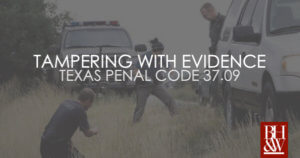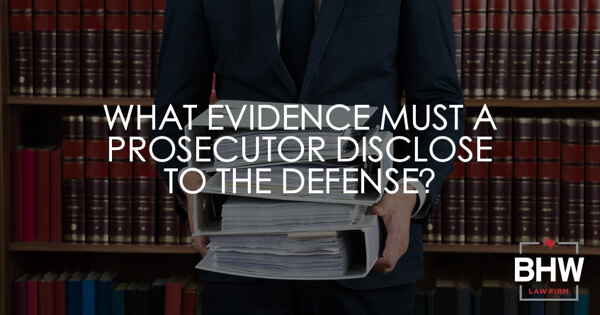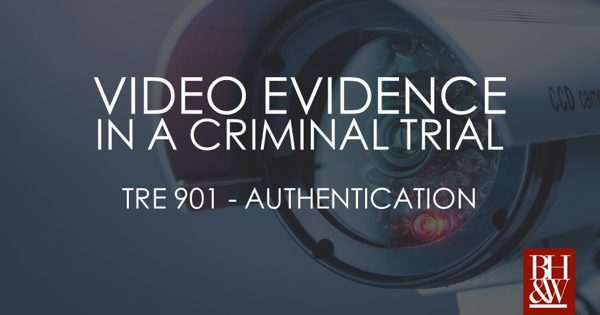 During routine traffic stops, police officers sometimes end up arresting individuals for the third-degree felony offense of Tampering with Evidence. How does this happen you ask? If, during the course of a traffic stop, an officer observes the driver toss an item or two out of the window, and those tossed items are later determined to be drugs and/or drug paraphernalia, the officer might just arrest the person for tampering with evidence pursuant to section 37.09 of the Texas Penal Code. The important question though, is whether section 37.09 was intended to prohibit this type of conduct?
During routine traffic stops, police officers sometimes end up arresting individuals for the third-degree felony offense of Tampering with Evidence. How does this happen you ask? If, during the course of a traffic stop, an officer observes the driver toss an item or two out of the window, and those tossed items are later determined to be drugs and/or drug paraphernalia, the officer might just arrest the person for tampering with evidence pursuant to section 37.09 of the Texas Penal Code. The important question though, is whether section 37.09 was intended to prohibit this type of conduct?
What is the Purpose of Section 37.09 – Tampering with Evidence?
Texas Penal Code Section 37.09 provides:
(a) A person commits an offense if, knowing that an investigation or official proceeding is pending or in progress, he:
(1) alters, destroys, or conceals any record, document, or thing with intent to impair its verity, legibility, or availability as evidence in the investigation or official proceeding; or
(2) makes, presents, or uses any record, document, or thing with knowledge of its falsity and with intent to affect the course or outcome of the investigation or official proceeding.
Texas courts have found that the purpose of section 37.09 is to uphold the integrity of our criminal justice system. 20 Tex. Jur. 3d Criminal Law: Offenses Against Public Administration § 63 citing Wilson v. State, 311 S.W.3d 452 (Tex. Crim. App. 2010); Haywood v. State, 344 S.W.3d 454 (Tex. App.—Dallas 2011 pet. ref’d). This includes prohibiting anyone from “creating, destroying, forging, altering, or otherwise tampering with evidence that may be used in an official investigation or judicial proceeding.” Id. However, section 37.09 is not without limitation.
What is the Scope of Section 37.09?
Early case law suggests the scope of 37.09 is very limited. But, as you will read below, the Court of Criminal Appeals rejects this notion by allowing the fact finder the ability infer the intent to tamper.
In Pannell v. State, 7 S.W.3d 222 (Tex. App.—Dallas 1999, pet. ref’d) the court of appeals held that section 37.09 requires a defendant to know that the item “altered, destroyed, or concealed, was evidence of an investigation, that is pending or in progress, as it existed at the time of the alteration, destruction, or concealment.” Id. In this case, the defendant threw a marijuana cigarette out of the window while he was being pulled over for speeding. Id. Because the officer was only investigating a speeding violation when the defendant threw the marijuana out of the window, the court held that there was no evidence that an investigation in which the marijuana would serve as evidence was “pending or in progress.” Id. The court explained that only after the officer observed the defendant throw out the marijuana did the investigation change to involve drugs. As a result, the court determined there was no evidence of tampering. This analysis, however, has been rejected, albeit not explicitly overruled, in Williams v. State, 270 S.W.3d 140 (Tex. Crim. App. 2008).
In Williams, an officer was conducting a traffic stop and decided to conduct a pat down search of the driver (i.e. defendant) for weapons. During the pat down a crack pipe fell onto the pavement, and the defendant immediately stomped on the pipe, crushing it with his foot. When deciding whether or not the above actions constituted tampering, the Court of Criminal Appeals rejected the lower court’s analysis, which stated that the traffic stop became a drug investigation once the officer and the defendant noticed the pipe on the pavement, and only then was there tampering. In rejecting this analysis, the Court held that requiring a change in the investigation, as the appellate court’s analysis and Pannell does, adds an additional mens rea element not required by section 37.09.
Thus, the Court held that when an officer is investigating a traffic stop and the suspect anticipates that the officer will begin a drug investigation if the officer finds evidence of drugs, and in accordance with that anticipation, the suspect destroys the drugs before the officer becomes aware of them, the suspect has tampered with evidence. As such, there is no requirement for the officer to “see the pipe” or “see the marijuana” before the suspect throws it out of the window in order for that action to constitute tampering. The determination will be made by the finder of fact using circumstantial evidence to draw inferences.
In Conclusion . . .
In conclusion, if the only evidence the State has of tampering is the fact that the defendant threw the item out of the window, without any other indicia of tampering, then the act alone does not rise to level of tampering under section 37.09. However, there are many reasonable circumstances, ever so slight, that could lend the fact finder to make an inference of intent to tamper. With that being said, because the offense of tampering is extremely fact-based, we recommend you reach out to our experienced attorneys to better understand your options.










